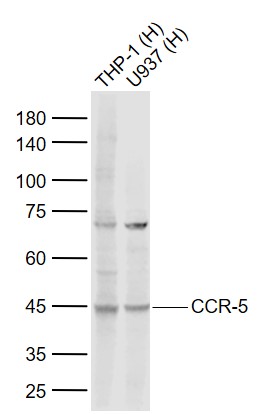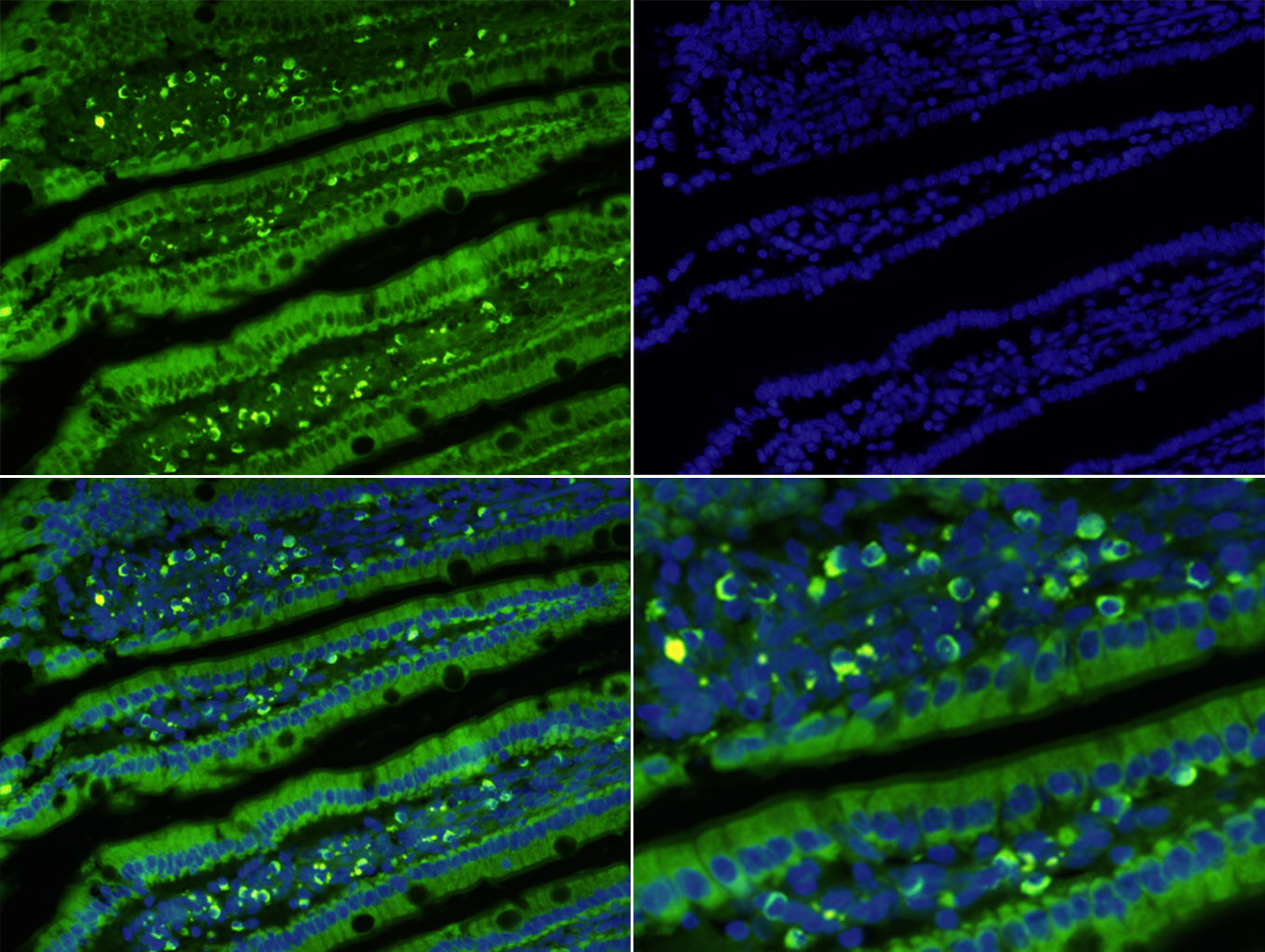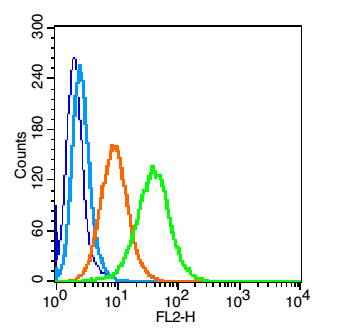
Rabbit Anti-CCR5 antibody
C-C chemokine receptor 5; CCR5; CC-CKR-5;CCR-5; CCCKR5; CD195; CD 195; CKR-5; CKR5; CMKBR5; FLJ78003; IDDM22; AM4-7; C C chemokine receptor type 5; C-C motif chemokine receptor 5 A159A; CC Chemokine Receptor Type 5; CCR5 chemokine (C C motif) receptor 5;
View History [Clear]
Details
Product Name CCR5 Chinese Name 细胞表面Chemokine受体5抗体 Alias C-C chemokine receptor 5; CCR5; CC-CKR-5;CCR-5; CCCKR5; CD195; CD 195; CKR-5; CKR5; CMKBR5; FLJ78003; IDDM22; AM4-7; C C chemokine receptor type 5; C-C motif chemokine receptor 5 A159A; CC Chemokine Receptor Type 5; CCR5 chemokine (C C motif) receptor 5; Chemokine receptor CCR5; CHEMR13; HIV 1 Fusion Coreceptor; HIV1 fusion coreceptor; IDDM22; MIP-1 alpha receptor; CCR5_HUMAN. literatures Research Area Cell biology immunology The cell membrane受体 Cell Surface Molecule Immunogen Species Rabbit Clonality Polyclonal React Species Human, Mouse, Rat, Applications WB=1:500-2000 ELISA=1:5000-10000 IHC-P=1:100-500 IHC-F=1:100-500 Flow-Cyt=1μg/Test IF=1:100-500 (Paraffin sections need antigen repair)
not yet tested in other applications.
optimal dilutions/concentrations should be determined by the end user.Theoretical molecular weight 40kDa Cellular localization The cell membrane Form Liquid Concentration 1mg/ml immunogen KLH conjugated synthetic peptide derived from human CCR-5: 201-300/352 <Cytoplasmic> Lsotype IgG Purification affinity purified by Protein A Buffer Solution 0.01M TBS(pH7.4) with 1% BSA, 0.03% Proclin300 and 50% Glycerol. Storage Shipped at 4℃. Store at -20 °C for one year. Avoid repeated freeze/thaw cycles. Attention This product as supplied is intended for research use only, not for use in human, therapeutic or diagnostic applications. PubMed PubMed Product Detail This gene encodes a member of the beta chemokine receptor family, which is predicted to be a seven transmembrane protein similar to G protein-coupled receptors. This protein is expressed by T cells and macrophages, and is known to be an important co-receptor for macrophage-tropic virus, including HIV, to enter host cells. Defective alleles of this gene have been associated with the HIV infection resistance. The ligands of this receptor include monocyte chemoattractant protein 2 (MCP-2), macrophage inflammatory protein 1 alpha (MIP-1 alpha), macrophage inflammatory protein 1 beta (MIP-1 beta) and regulated on activation normal T expressed and secreted protein (RANTES). Expression of this gene was also detected in a promyeloblastic cell line, suggesting that this protein may play a role in granulocyte lineage proliferation and differentiation. This gene is located at the chemokine receptor gene cluster region. Two transcript variants encoding the same protein have been found for this gene. [provided by RefSeq].
Function:
Receptor for a number of inflammatory CC-chemokines including MIP-1-alpha, MIP-1-beta and RANTES and subsequently transduces a signal by increasing the intracellular calcium ion level. May play a role in the control of granulocytic lineage proliferation or differentiation. Acts as a coreceptor (CD4 being the primary receptor) for HIV-1 R5 isolates.
Subunit:
Interacts with PRAF2. Interacts with HIV-1 surface protein gp120. Efficient ligand binding to CCL3/MIP-1alpha and CCL4/MIP-1beta requires sulfation, O-glycosylation and sialic acid modifications. Glycosylation on Ser-6 is required for efficient binding of CCL4. Interacts with ADRBK1. Interacts with ARRB1 and ARRB2. Interacts with human cytomegalovirus/HHV-5 protein UL78.
Subcellular Location:
Cell membrane; Multi-pass membrane protein.
Tissue Specificity:
Highly expressed in spleen, thymus, in the myeloid cell line THP-1, in the promyeloblastic cell line KG-1A and on CD4+ and CD8+ T-cells. Medium levels in peripheral blood leukocytes and in small intestine. Low levels in ovary and lung.
Similarity:
Belongs to the G-protein coupled receptor 1 family.
SWISS:
P51681
Gene ID:
1234
Database links:Entrez Gene: 1234 Human
Entrez Gene: 12774 Mouse
Omim: 601373 Human
SwissProt: P51681 Human
SwissProt: P51682 Mouse
Unigene: 450802 Human
Product Picture
Lane 1: Human THP-1 cell lysates
Lane 2: Human U937 cell lysates
Primary: Anti-CCR-5 (SL2514R) at 1/1000 dilution
Secondary: IRDye800CW Goat Anti-Rabbit IgG at 1/20000 dilution
Predicted band size: 40 kD
Observed band size: 43 kD
Tissue/cell: mouse intestinal tissue;4% Paraformaldehyde-fixed and paraffin-embedded;
Antigen retrieval: citrate buffer ( 0.01M, pH 6.0 ), Boiling bathing for 15min; Blocking buffer (normal goat serum,C-0005) at 37℃ for 20 min;
Incubation: Anti-CCR5 Polyclonal Antibody, Unconjugated(SL2514R-FITC) 1:100, overnight at 4°C; DAPI(5ug/ml,blue,C-0033) was used to stain the cell nuclei
Blank control(blue): U937(fixed with 2% paraformaldehyde (10 min)) .
Primary Antibody:Rabbit Anti-CCR5 antibody(SL2514R), Dilution: 1μg in 100 μL 1X PBS containing 0.5% BSA;
Isotype Control Antibody: Rabbit IgG(orange) ,used under the same conditions );
Secondary Antibody: Goat anti-rabbit IgG-PE(white blue), Dilution: 1:200 in 1 X PBS containing 0.5% BSA.
References (0)
No References
Bought notes(bought amounts latest0)
No one bought this product
User Comment(Total0User Comment Num)
- No comment





 +86 571 56623320
+86 571 56623320
 +86 18668110335
+86 18668110335

